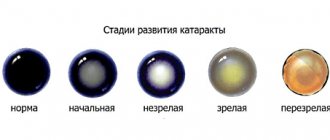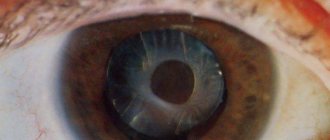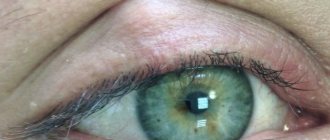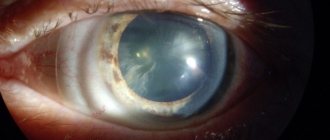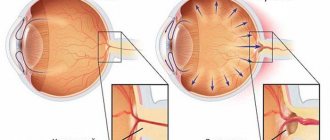Posterior capsular cataract is clouding of the back of the lens. It is considered a complicated form, prone to rapid progression. It occurs in all ages, but more often in the elderly, and in all sexes, but more often in women. If left untreated, the disease leads to complete loss of vision.
What is posterior capsular cataract
Loss of lens transparency that begins in the posterior capsule of the natural lens is called posterior capsular cataract. There are several stages and forms of the disease:
- Initial. The first changes appear in the area of the posterior capsule. Symptoms are minimal: spots before the eyes, double vision, fog in front of the eyes.
- Immature, or swelling. The lens becomes saturated with water, increases in size, and acquires a whitish tint. Visual functions deteriorate significantly.
- Mature. The lens hardens and shrinks. Objects appear very pale, barely visible, with light reflections and halos.
- Overripe. The lens liquefies, that is, it completely changes its structure and collapses. A person at this stage cannot even distinguish between light rays.
Types of disease
Complicated cataract develops in the organ of vision and has four stages:
- Initial form - factors arise that contribute to the infiltrate accumulating towards the eye. Visual acuity remains virtually unchanged, sometimes there is slight blurring that lasts for a short time.
- Immature cataract - the lens is already seriously clouded. A significant decrease in visual acuity can be observed.
- Mature cataract - allows you to see with the naked eye how the layering of infiltration occurred. The eye color becomes milky.
- Overripe cataract - the damaged eye practically ceases to see.
The infiltrate can be localized in various places, causing the disease to be posterior capsular or swelling.
Causes
Posterior subcapsular cataracts result from a wide range of causes. We must try to avoid harmful effects on the body and treat diseases of the eyes and internal organs.
Possible causes of posterior capsular cataract:
- age-related changes;
- heredity;
- long-term use of glucocorticosteroids;
- eye diseases;
- injuries, burns of the visual organ;
- hormonal and autoimmune diseases;
- radiation;
- intoxication;
- bad habits;
- harmful working conditions;
- negative environmental factors.
Incomplete complicated cataract
Let's try to figure out what it is? So, complicated incomplete cataract is a malaise, the consequence of which is clouding of the eye lens due to various diseases or inflammations occurring in the body, as well as due to the negative impact of external factors. The disease can develop in a patient of any age, but the latter affects the level of intensification of the disease. During the formation of pathology, the delivery of nutrients to the eye lens is disrupted, and it is also exposed to toxic substances. The result of the development of the disease is the covering of the lens with cloudy spots, due to which vision impairment occurs.
Symptoms
With posterior capsular cataracts, gradual deterioration of vision occurs:
- the image becomes blurry, dull, colors seem pale;
- a veil appears before the eyes;
- eye adaptation worsens in a dimly lit room;
- sensitivity to light increases;
- part of the field of view disappears.
Because the visual apparatus has difficulty examining objects, the eyes begin to quickly get tired, and a headache occurs.
Diagnostics
The following studies help determine lens opacification, as well as establish the form of the disease:
- Biomicroscopy and ophthalmoscopy. These methods allow you to assess the condition of the structures of the eye and fundus.
- Visometry, perimetry, tonometry. These methods are needed to assess the preservation of visual functions and identify other pathologies that may complicate a person’s condition.
- Electrophysiological studies. Allows you to evaluate the bioelectrical activity of the organ.
- Ultrasound of the eyeballs. An ultrasound examination is necessary to determine the size of the eyes, echogenicity, the presence of pathological formations and other changes in the eyes.
If posterior capsular cataract is caused by diseases of the internal organs, then you need to contact the appropriate doctors for additional examinations and selection of treatment.
Provoking factors
The accumulation of toxins in the intraocular fluid can be caused by both external and internal factors. However, the underlying disease does not always have a direct connection with the organs of vision. The main factor provoking pathological changes in the lens is intoxication that occurs during the inflammatory process.
Ophthalmological diseases that often lead to the development of a complicated form of cataract:
- Chorioretinitis. This disease is characterized by inflammation of the blood vessels and retina as a side effect of infection with viruses - toxoplasma, cytomegalovirus. Weakened immunity during HIV infection is also fertile ground for the development of first chorioretinitis and then complicated cataracts.
- Iridocyclitis. In this case, the iris, ciliary body, and vascular network become inflamed. A characteristic sign of the disease is a change in the pattern of the iris, redness of the sclera, pain, and intense lacrimation. If treatment is incorrect or absent, changes in the structures of the eye lead to the development of cataracts.
- Fuchs syndrome. This term is used to define a pathology in which the tissue of the iris of the eye changes and becomes inflamed.
Various viruses and infections, even if they are not associated with the organs of vision, but are accompanied by severe intoxication, lead to the accumulation of toxins in the eyes and damage to the lens
There are also systemic infectious diseases that lead to intoxication of the body, including eye tissue. The underlying pathologies for complicated cataracts may include:
Cataract treatment
- typhus;
- malaria;
- smallpox;
- rheumatoid arthritis.
In addition, the cause of cataracts with complications can be pathological conditions of the body caused by metabolic disorders. These include:
- diabetes;
- anemia;
- iodine deficiency;
- pathology of the thyroid gland.
Often complicated cataracts accompany hypertension and occur in people suffering from anorexia, severe exhaustion of the body after forced or deliberate fasting.
Therapy with certain medications can increase the likelihood of developing pathology. Glucocorticoids, adrenaline or pilocarpine drugs provoke cataracts. In young children, congenital complicated cataracts are often a consequence of intrauterine uvitis.
X-rays, ultrasound, and radiation rays can also provoke pathological changes in the lens and the development of cataracts
Important: frequent and intense exposure to X-ray, ultrasound, and radium radiation also causes intoxication of the eye structures. At the same time, complicated radiation cataracts occur mainly in young people, since after 50 years the body becomes less susceptible to various types of aggressive rays.
Treatment
Posterior capsular cataracts of both or one eye are subject to surgical treatment. Surgery is the only effective treatment method. No drops, eye gymnastics, or folk methods will help.
Possible operations:
- Phacoemulsification with IOL implantation. The essence of the method is to destroy the lens substance using ultrasound or laser and then remove it. An intraocular lens is installed in the vacant space, which replaces the lens.
- Extraction. The operation consists of removing the altered lens using surgical instruments. In extracapsular extraction, only the lens substance is removed, preserving the capsule. In intracapsular, it is removed along with the capsule. Then an artificial lens is inserted.
Laser or ultrasound treatment are more modern methods of removing posterior capsular cataracts, which are characterized by minimal tissue trauma, which shortens the recovery period. Phacoemulsification is practically painless, performed quickly, and does not require sutures.
Classic surgical removal is associated with long recovery, pain, and an increased risk of complications.
See in addition the story about laser treatment of cataracts:
Therapy tactics
Immature cataracts are treated with conservative methods or through surgery.
Conservative treatment
For cataracts developing at an early stage, the ophthalmologist usually prescribes drugs that stimulate the resorption of insoluble protein fractions. The patient uses them for several months, after which a re-examination occurs.
If the doctor detects a tendency towards recovery, there is no need for surgery. The patient's dosage is adjusted and recommended to adhere to a diet that significantly limits protein intake.
The disease requires surgery to eliminate the clouding and completely restore vision. In this case, the patient undergoes laboratory tests and undergoes all necessary types of research. If there are no contraindications, he is assigned a day on which the operation will be performed.
Surgery
Doctors recommend a microsurgical method - phacoemulsification using ultrasound. Subsequently, a multifocal or monofocal lens is installed. The procedure is performed on an outpatient basis and includes the following steps:
- taking an antibacterial agent several days before surgery to prevent the risk of infection as a result of surgery;
- application of anesthesia to a patient lying on a couch;
- making a microscopic incision in the cornea to provide access to the lens;
- removal of the lens by introducing a special substance, due to which it softens and turns into an emulsion, while the lens capsule remains intact;
- installation of multifocal or monofocal lenses with a hypoallergenic composition that prevents rejection reactions;
- application of a bactericidal dressing.
Modern operations do not require stitches, which eliminates the presence of scars. Since the lens does not contain nerve endings, it cannot hurt during the postoperative period. Removing immature cataracts through surgery avoids the complications that arise as a result of this disease.
The surgical procedure is performed with virtually no damage to the tissue structures of the organ of vision. The rehabilitation period after such operations passes quite quickly, and the patient returns to a full life in the shortest possible time. However, at first he is recommended to rest and completely avoid physical activity.
In rare cases, complications may occur such as:
- displacement of the inserted lens and damage to surrounding tissues;
- intraocular hemorrhage (major or small);
- the appearance of spots on the eyes;
- damage during the procedure to the internal elements of the organ of vision.
Despite possible complications, ophthalmologists still recommend surgery. This is due to the fact that in the absence of such measures, more serious complications will arise. The patient will completely lose vision and this will be irreparable.
Useful video
Immature cataract of the eye and its treatment:
Prevention
You can reduce the risk of developing posterior capsular cataracts by following preventive measures:
- maintaining a healthy lifestyle;
- rejection of bad habits;
- protecting eyes from injury and negative environmental influences;
- preventive intake of vitamins;
- annual medical examination.
Posterior capsular cataracts can lead to blindness and disability. Therefore, it is necessary to carry out surgical treatment as early as possible.
What do you know about posterior capsular cataracts? Share in the comments. Repost on social networks. Take care of your eyesight. Be healthy.
